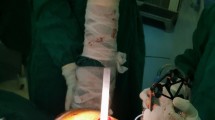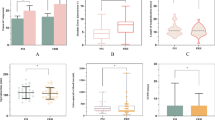Abstract
Postoperative complications due to inaccurate prosthesis positioning are the main causes of early revision. The aim of this study was to (1) determine whether novel designed whole-process robotic assisted hip system allowed better radiographic outcomes and lower complications risk on the femoral side particularly stem subsidence compared to conventional THA, and to (2) identify the comparison of early clinical outcomes. 72 patients were initially enrolled and randomly divided into 2 groups. Finally, only 65 patients (31 RA-THAs, 34 C-THAs) were analyzed who had full 18-month follow-up data. Radiographic follow-up was performed at immediate and 6-month postoperatively, while clinical follow-up at 18-month postoperatively. Stem-related radiographic outcomes, femoral side complications and clinical scores were compared. The robotic arm allowed better radiographic outcomes of the femoral side, including a higher canal fill ratio (CFR) at B1 (P = 0.040), more neutral stem alignment (P = 0.029), lower subsidence (P = 0.023) and lower leg length discrepancy (LLD) (P = 0.010). In addition, low CFR at B1 (P = 0.001) was found the risk factor for subsidence. However, early clinical outcomes were consistent between both groups. The novel designed whole-process robotic assisted hip system covers both femoral and acetabular side operations. It allows accurate and safe manipulation of femoral side, including better stem-related radiographic outcomes and lower risk of subsidence and LLD. However, no advantage of robotic system in early clinical score was identified. Clinical trial registration number: ChiCTR2100044124.





Similar content being viewed by others
Data availability
No datasets were generated or analysed during the current study.
References
Ledford CK, Perry KI, Hanssen AD et al (2019) What are the contemporary etiologies for revision surgery and revision after primary, noncemented total hip arthroplasty? J Am Acad Orthop Surg 27:933–938. https://doi.org/10.5435/JAAOS-D-17-00842
Barrack RL, Krempec JA, Clohisy JC et al (2013) Accuracy of acetabular component position in hip arthroplasty. J Bone Joint Surg Am 95:1760–1768. https://doi.org/10.2106/JBJS.L.01704
Wang W, Zhang Z, Wang G et al (2023) Prospective randomized controlled trial on the accuracy of prosthesis positioning in total hip arthroplasty assisted by a newly designed whole-process robotic arm. Int Orthop 47:413–419. https://doi.org/10.1007/s00264-022-05501-2
Ries C, Boese CK, Dietrich F et al (2019) Femoral stem subsidence in cementless total hip arthroplasty: a retrospective single-centre study. Int Orthop 43:307–314. https://doi.org/10.1007/s00264-018-4020-x
Bornes TD, Radomski LR, Bonello JP et al (2023) Subsidence of a single-taper femoral stem in primary total hip arthroplasty: characterization, associated factors, and sequelae. J Arthroplasty 38:S174–S178. https://doi.org/10.1016/j.arth.2023.04.026
Adams CT, O’Leary RE, Gheewala RA et al (2021) Evolving patient perception of limb length discrepancy following total hip arthroplasty. J Arthroplasty 36:S374–S379. https://doi.org/10.1016/j.arth.2021.02.080
Konyves A, Bannister GC (2005) The importance of leg length discrepancy after total hip arthroplasty. J Bone Joint Surg Br 87:155–157. https://doi.org/10.1302/0301-620x.87b2.14878
Gromov K, Bersang A, Nielsen CS et al (2017) Risk factors for post-operative periprosthetic fractures following primary total hip arthroplasty with a proximally coated double-tapered cementless femoral component. Bone Joint J 99:451–457. https://doi.org/10.1302/0301-620X.99B4.BJJ-2016-0266.R2
Hodge WA, Andriacchi TP, Galante JO (1991) A relationship between stem orientation and function following total hip arthroplasty. J Arthroplasty 6:229–235. https://doi.org/10.1016/s0883-5403(06)80169-5
Singh V, Realyvasquez J, Simcox T et al (2021) Robotics versus navigation versus conventional total hip arthroplasty: does the use of technology yield superior outcomes? J Arthroplasty 36:2801–2807. https://doi.org/10.1016/j.arth.2021.02.074
Karrholm J, Borssen B, Lowenhielm G et al (1994) Does early micromotion of femoral stem prostheses matter? 4-7-year stereoradiographic follow-up of 84 cemented prostheses. J Bone Joint Surg Br 76:912–917
Campbell D, Mercer G, Nilsson KG et al (2011) Early migration characteristics of a hydroxyapatite-coated femoral stem: an RSA study. Int Orthop 35:483–488. https://doi.org/10.1007/s00264-009-0913-z
Dammerer D, Blum P, Putzer D et al (2022) Migration characteristics of the Corail hydroxyapatite-coated femoral stem-a retrospective clinical evaluation and migration measurement with EBRA. Arch Orthop Trauma Surg 142:517–524. https://doi.org/10.1007/s00402-021-03926-9
Yang Y, Fu G, Li Q et al (2022) Multivariable analysis of risk factors affecting dislocation after bipolar hemiarthroplasty in patients with femoral neck fracture. Ther Clin Risk Manag 18:101–111. https://doi.org/10.2147/TCRM.S350213
D’Ambrosio A, Peduzzi L, Roche O et al (2020) Influence of femoral morphology and canal fill ratio on early radiological and clinical outcomes of uncemented total hip arthroplasty using a fully coated stem. Bone Joint Res 9:182–191. https://doi.org/10.1302/2046-3758.94.BJR-2019-0149.R2
Luger M, Stiftinger J, Allerstorfer J et al (2022) High varus stem alignment in short-stem total hip arthroplasty: a risk for reconstruction of femoro-acetabular offset, leg length discrepancy and stem undersizing? Arch Orthop Trauma Surg 142:2935–2944. https://doi.org/10.1007/s00402-021-04176-5
Dastane M, Dorr LD, Tarwala R et al (2011) Hip offset in total hip arthroplasty: quantitative measurement with navigation. Clin Orthop Relat Res 469:429–436. https://doi.org/10.1007/s11999-010-1554-7
Viamont-Guerra MR, Ramos-Pascual S, Saffarini M et al (2023) Effect of femoral stem surface coating on clinical and radiographic outcomes of cementless primary total hip arthroplasty: a patient-matched retrospective study. Int Orthop 47:165–174. https://doi.org/10.1007/s00264-022-05629-1
Fujii M, Kitamura K, Ikemura S et al (2022) Pneumatic femoral broaching decreases post-operative subsidence of a cementless taper-wedge stem. Int Orthop 46:233–240. https://doi.org/10.1007/s00264-021-05196-x
Innmann MM, Streit MR, Kolb J et al (2015) Influence of surgical approach on component positioning in primary total hip arthroplasty. BMC Musculoskelet Disord 16:180. https://doi.org/10.1186/s12891-015-0623-1
Meermans G, Malik A, Witt J et al (2011) Preoperative radiographic assessment of limb-length discrepancy in total hip arthroplasty. Clin Orthop Relat Res 469:1677–1682. https://doi.org/10.1007/s11999-010-1588-x
Foissey C, Batailler C, Coulomb R et al (2023) Image-based robotic-assisted total hip arthroplasty through direct anterior approach allows a better orientation of the acetabular cup and a better restitution of the centre of rotation than a conventional procedure. Int Orthop 47:691–699. https://doi.org/10.1007/s00264-022-05624-6
Hamilton DF, Giesinger JM, MacDonald DJ et al (2016) Responsiveness and ceiling effects of the Forgotten Joint Score-12 following total hip arthroplasty. Bone Joint Res 5:87–91. https://doi.org/10.1302/2046-3758.53.2000480
Bendich I, Vigdorchik JM, Sharma AK et al (2022) Robotic assistance for posterior approach total hip arthroplasty is associated with lower risk of revision for dislocation when compared to manual techniques. J Arthroplasty 37:1124–1129. https://doi.org/10.1016/j.arth.2022.01.085
Leiss F, Gotz JS, Meyer M et al (2022) Differences in femoral component subsidence rate after THA using an uncemented collarless femoral stem: full weight-bearing with an enhanced recovery rehabilitation versus partial weight-bearing. Arch Orthop Trauma Surg 142:673–680. https://doi.org/10.1007/s00402-021-03913-0
Huang Z, Zhang Z, Lu X et al (2023) The influence of prosthetic positioning and proximal femoral morphology on leg length discrepancy and early clinical outcomes of cementless total hip arthroplasty. J Orthop Surg Res 18:408. https://doi.org/10.1186/s13018-023-03847-w
Kobayashi S, Eftekhar NS, Terayama K (1994) Predisposing factors in fixation failure of femoral prostheses following primary Charnley low friction arthroplasty. A 10- to 20-year followup study. Clin Orthop Relat Res 306:73–83
McKibbin B (1970) Anatomical factors in the stability of the hip joint in the newborn. J Bone Joint Surg Br 52:148–159
Barrack RL, Thornberry RL, Ries MD et al (2001) The effect of component design on range of motion to impingement in total hip arthroplasty. Instr Course Lect 50:275–280
Kim HS, Lee YK, Ha JH et al (2022) Distribution and outliers of anteversion of short-length cementless stem. Int Orthop 46:725–732. https://doi.org/10.1007/s00264-021-05265-1
Sariali E, Klouche S, Mouttet A et al (2014) The effect of femoral offset modification on gait after total hip arthroplasty. Acta Orthop 85:123–127. https://doi.org/10.3109/17453674.2014.889980
Robinson M, Bornstein L, Mennear B et al (2012) Effect of restoration of combined offset on stability of large head THA. Hip Int 22:248–253. https://doi.org/10.5301/HIP.2012.9283
Cassidy KA, Noticewala MS, Macaulay W et al (2012) Effect of femoral offset on pain and function after total hip arthroplasty. J Arthroplasty 27:1863–1869. https://doi.org/10.1016/j.arth.2012.05.001
Hu X, Zheng N, Chen Y et al (2021) Optimizing the femoral offset for restoring physiological hip muscle function in patients with total hip arthroplasty. Front Bioeng Biotechnol 9:645019. https://doi.org/10.3389/fbioe.2021.645019
Chen X, Xiong J, Wang P et al (2018) Robotic-assisted compared with conventional total hip arthroplasty: systematic review and meta-analysis. Postgrad Med J 94:335–341. https://doi.org/10.1136/postgradmedj-2017-135352
Warth LC, Grant TW, Naveen NB et al (2020) Inadequate metadiaphyseal fill of a modern taper-wedge stem increases subsidence and risk of aseptic loosening: technique and distal canal fill matter! J Arthroplasty 35:1868–1876. https://doi.org/10.1016/j.arth.2020.02.024
Schwartz JT Jr, Mayer JG, Engh CA (1989) Femoral fracture during non-cemented total hip arthroplasty. J Bone J Surg Am 71:1135–1142
Funding
The authors declare that no funds, grants, or other support was received during the preparation of this manuscript.
Author information
Authors and Affiliations
Contributions
ZH: completed all the table and figure, wrote the paper, and edited the manuscript. ZZ: collected the data and revised the paper. WW: measured the imaging parameters. XL: analyzed the statistics. HZ: designed the whole study and revised the manuscript. All the authors have read and approved the final manuscript.
Corresponding author
Ethics declarations
Conflict of interest
The authors declare that they have no competing interests.
Ethical approval
This study was performed in line with the principles of the Declaration of Helsinki. Approval was granted by the Institutional Review Board of The Affiliated Hospital of Qingdao University (QYFYEC2020-017-01).
Clinical trial registration number
ChiCTR2100044124 (date of registration: 2021-3-11).
Consent to participate
Informed consent was obtained from all individual participants included in the study.
Consent to publish
The authors affirm that human research participants provided informed consent for publication of the images in all figures.
Additional information
Publisher's Note
Springer Nature remains neutral with regard to jurisdictional claims in published maps and institutional affiliations.
Rights and permissions
Springer Nature or its licensor (e.g. a society or other partner) holds exclusive rights to this article under a publishing agreement with the author(s) or other rightsholder(s); author self-archiving of the accepted manuscript version of this article is solely governed by the terms of such publishing agreement and applicable law.
About this article
Cite this article
Huang, Z., Zhang, Z., Wang, W. et al. Improved radiographic outcomes and decreased complications rate on the femoral side can be achieved by a novel designed whole-process robotic assisted hip system for total hip arthroplasty: a prospective randomized controlled trial. J Robotic Surg 18, 79 (2024). https://doi.org/10.1007/s11701-024-01835-8
Received:
Accepted:
Published:
DOI: https://doi.org/10.1007/s11701-024-01835-8




